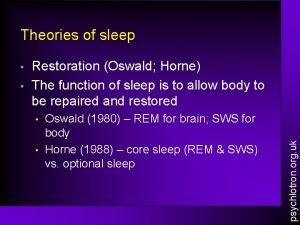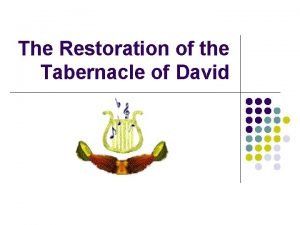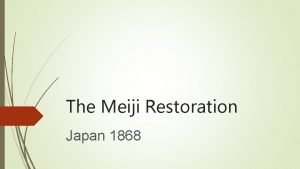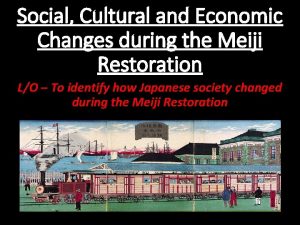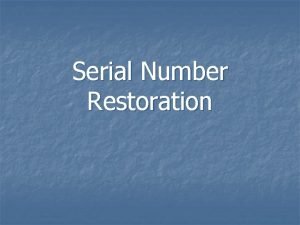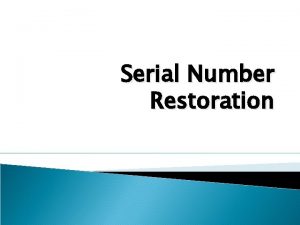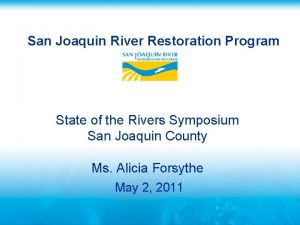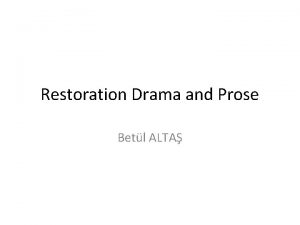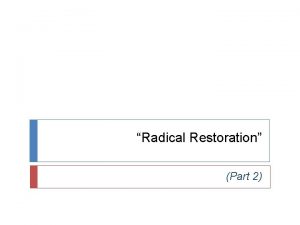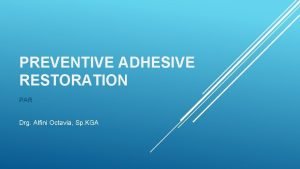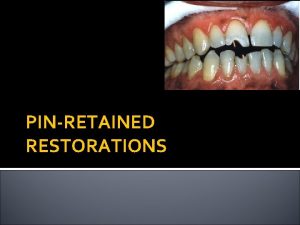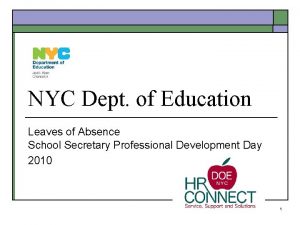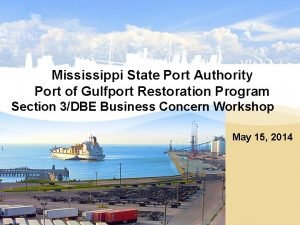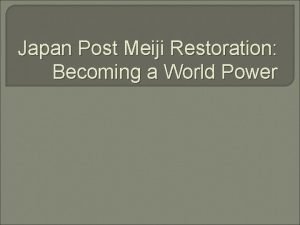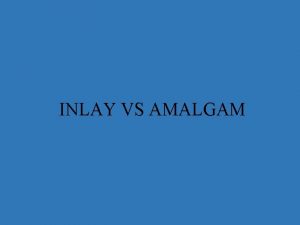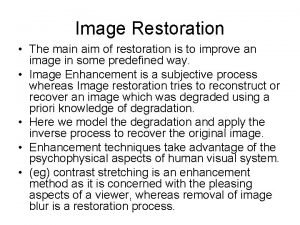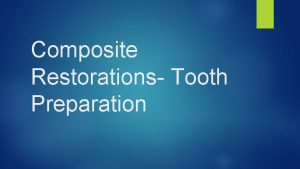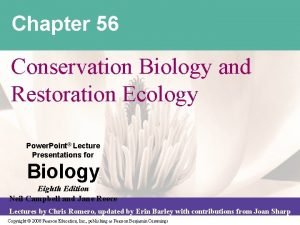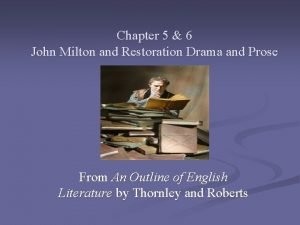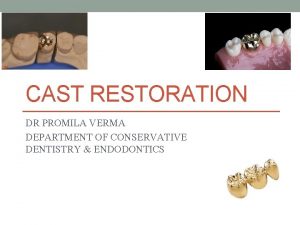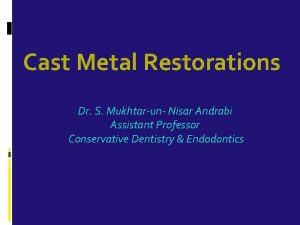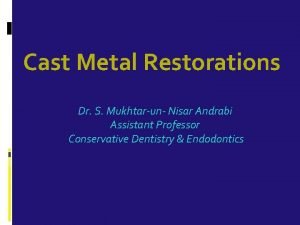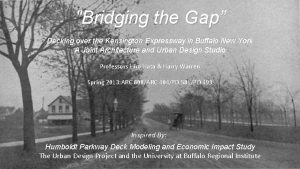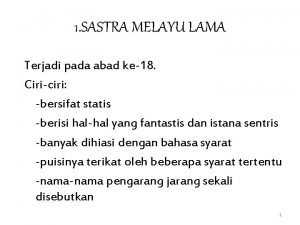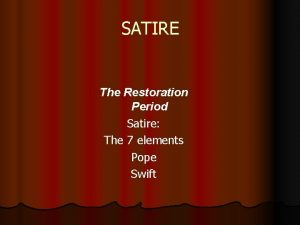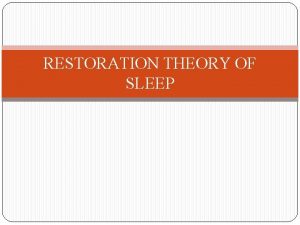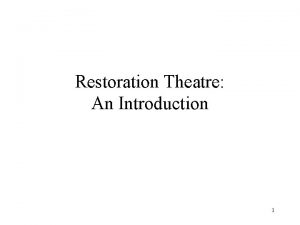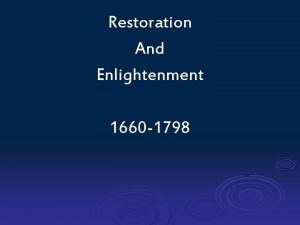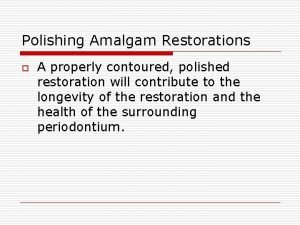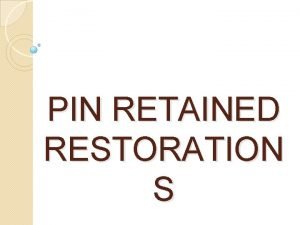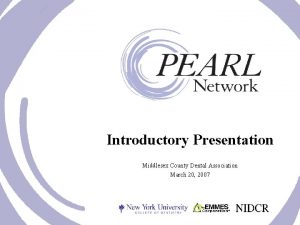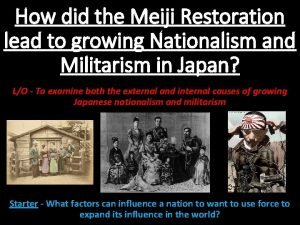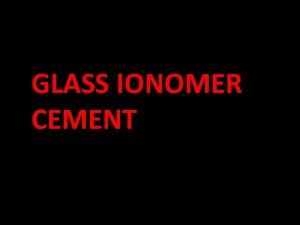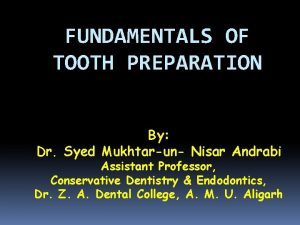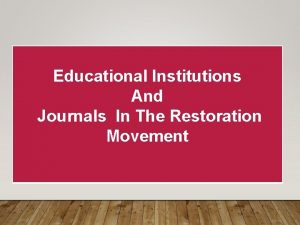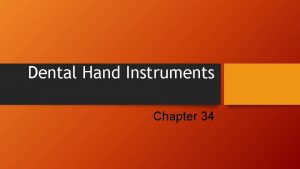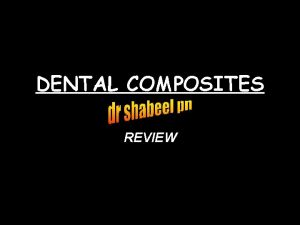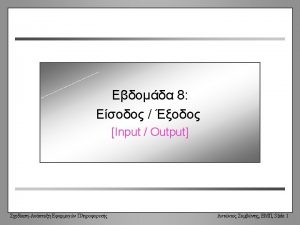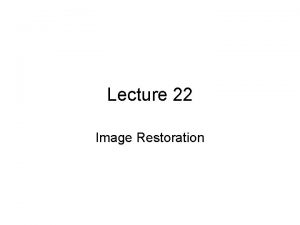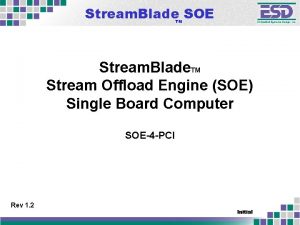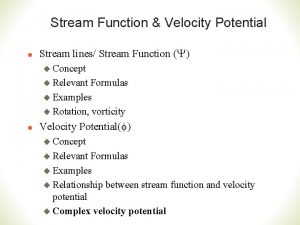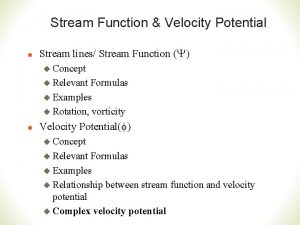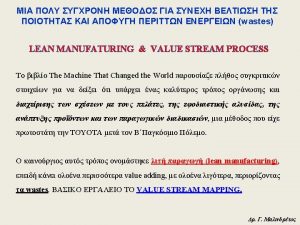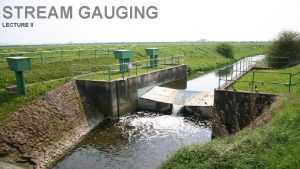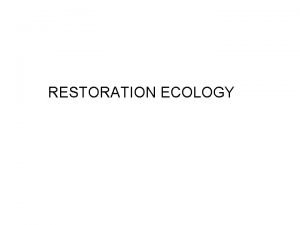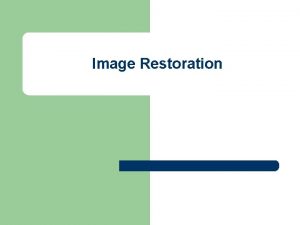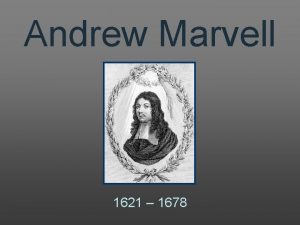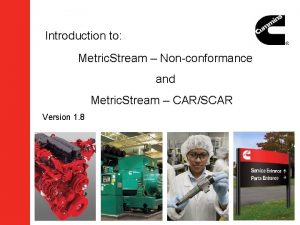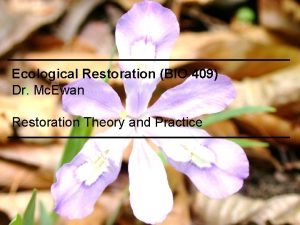Introduction to Stream Restoration Week 1 Copyright Andrew



















































- Slides: 51

Introduction to Stream Restoration Week 1 Copyright © Andrew Collison 2002 Photo from Alberta Fish Habitat Manual

Course logistics • This is a quantitative topic: math as required • In-class work: GIS, field work & report • Quick notes • Skills test

Wide range of projects called “Stream Restoration” Small-scale bank stabilization or revegetation Arlington, VA Dept. of Environmental Resources Complete channel realignment or redesign

SR is not well defined but there are several consistent elements • A desire for a more “natural looking” channel • Integrate ecology & geomorphology with engineering • Work with natural processes (selfsustaining design) • Avoid hard structures Arlington, VA Dept. of Environmental Resources

Bassett Creek case study

Bassett Creek case study

Bassett Creek case study

Bassett Creek case study

Bassett Creek case study

Bassett Creek case study

Bassett Creek case study

Bassett Creek case study

Bassett Creek case study

Bassett Creek case study

Bassett Creek case study

Primary reasons stream restoration is done in the United States WQM – Water Quality Mgmt. RM – Riparian Mgmt. IHI – Instream habitat improvement FP – Fish Passage BS – Bank stabilization FM – Flow modification A/R/E – Aesthetics/recreation/education CR – Channel reconfiguration DR/R – Dam removal/retrofit SM – Stormwater mgmt. FR – Floodplain reconnection ISM – Instream species mgmt. LA – Land acquisition From Bernhardt et al. , 2005

Current Status of field • >$1 billion is spent each year on stream restoration projects (Bernhardt et al. , 2005) • Little predictive science to back up restoration designs • Few post-project assessments done (funding) • High rates of design failure – Survey of 161 fish habitat structures in Oregon/Washington found 18. 5% failed and 60% were damaged in 2 -10 year event (Frissell and Nawa, 1992) – Survey of 400 habitat enhancement structures in Alberta found that 33% had low or zero effectiveness (O’Neil and Fitch, 1992) • Vast majority of projects are designed using “natural channel design” coupled with the Rosgen reference reach approach

There is a current “standard method” for stream restoration, called Natural Channel Design, or the Rosgen method Dave Rosgen, P. H. , Ph. D Wildland Hydrology Ft. Collins, Colorado

Dave Rosgen, monitoring biological function !

Unstable C 4 Stream Type

Stable-Reference Reach - C 4

So why don’t we just teach the Rosgen method? • It’s a little too “cook book” in our view • Insufficient emphasis on basic process understanding • There are plenty of other places where you can learn it (for a fee…)

Elements to the Uof M/NCED* approach • Emphasis on design based on analysis and prediction, not analogy • Emphasis on placing SR projects in watershed context • Emphasis on integrating historical records *NCED is the National Center for Earth-surface Dynamics, an NSF Sci-Tech center devoted to surface processes, including SR. More about NCED later.

Basic steps to a restoration project – most of these steps require an interdisciplinary approach • Problem identification – what is wrong? Is it actually a problem? • Societal context –stakeholders interests, funding sources, regulations, cultural issues, etc. • Define achievable goals - be specific • Assess site at watershed-level (best to act at watershed level if possible, or at least understand constraints on system), and at the reach-level, including longitudinal and lateral connectivity • Identify alternatives, evaluate, and choose design • Implementation – including construction monitoring • Monitoring and assessment; Adaptive management

Goals of this course/program • Balance basic fundamentals of fluvial geomorphology, hydrology, and ecology with practical information • “EMT” level of understanding for restoring damaged streams • Focus on ability to evaluate and critique restoration project (learn from past failures and successes) • Tools to design relatively simple restoration projects on small streams • Turn you into effective team members on restoration projects • Give you the tools to do both a watershed-scale assessment and a reach-scale analysis of a potential site and make you think about a river over multiple temporal and spatial scales.

This program will NOT teach you… • How to design large-scale restoration projects: this requires a team of subjectarea experts and years of experience • How to work in highly urbanized settings, where life and property are at risk • Rosgen’s toolbox for natural channel design: There are numerous short courses to learn this tool, including a series by the MN DNR

Common major considerations in restoration design • Habitat: – Water temperature – Topographic complexity – Desirable ranges of U, h • Channel stability – ability to convey high flows without major changes in form • Pollutant reduction (e. g. susp. sediment) • Nutrient processing – especially N, P • Esthetics & recreation

Overall Words of Advice for the River Restorer: FIRST, DO NO HARM! “There is renewed emphasis on recovering damaged rivers (Baringa 1996). Along with this concern, however, people should be reminded periodically that they serve as stewards of watersheds, not just tinkerers with stream sites. Streams in pristine condition, for example, should not be artificially “improved” by active rehabilitation methods. At the other end of the spectrum, and particularly where degradation is caused by off-stream activities, the best solution to a river management problem might be to remove the problem sources and “let it heal itself”. Unfortunately, in severely degraded streams, this process can take a long time. Therefore the “leave it alone” concept can be the most difficult approach for people to accept (Gordon et al. 1992). ” From FISRG, 1998, Stream Corridor Restoration, p. 8 -2.

Some additional perspectives…

Restoration State of Art Craig Fischenich • State of practice generally lags state of art by about 10 years – not true for restoration • Stream restoration has evolved as a practice rather than a science • Current practice generally reflects the state of art from about 50 years ago • Progress is slow and redundancy rampant

Restoration is the return of the form and function of an ecosystem to some pre-disturbance condition.

We Can: We Can’t (or Won’t): Characterize evolutionary changes in streams Determine when they will occur or quantify magnitude Develop sophisticated analytical tools and models Get practitioners to use them Identify specific causal mechanisms of disturbance Assess the cumulative effects of multiple causes Optimize habitat for a particular species or guild Optimize habitat for a community across trophic levels

We Can: We Can’t (or Won’t): Stabilize channels and banks Allow for a full range of dynamic processes Identify project objectives Relate these to meaningful standards or metrics Design systems that mimic reference conditions Ensure that they are appropriate or functional Characterize ANY action as restoration Fully restore both the form and function of most systems to pre-disturbance

We Can: We Can’t (or Won’t): Identify broad ecosystems in need of restoration Execute comprehensive, integrated restoration over large spatial areas Develop monitoring plans Fund and execute monitoring plans Use multi-disciplinary approaches in design Use inter-disciplinary approaches in design Acknowledge risk and uncertainty Quantify and manage risk and uncertainty

Some Reflections on River Restoration and Research Matt Kondolf, University of California, Berkeley

Six Points in Ten Minutes: -----------------------------------1. Extent of river restoration, scale of investment 2. Lack of monitoring and evaluation 3. Most projects designed using empirical approaches from 1950 s, need to update (But it’s not just hydraulics/sediment – big picture!) 4. Recognize changed conditions of rivers continuum: wilderness ---- fully urban 5. Cultural preference for stable, meandering channels? 6. Implications for goals, assessing success -----------------------------------

Extent of Restoration in US NRRSS (National River Restoration Sci Synthesis) Seven nodes covering 20 states Northwest Pacific NW, Interior Columbia Basin Northern Rockies Goodwin, Stanford, Clayton, Relyea California Sacramento. San Joaquin Basin Kondolf Southwest Catchments in Rio Grande and Colorado River Basins Shah, Dahm, Gloss Upper mid-west Michigan, Indiana, Wisconsin Alexander, Allan, Gergel Chesapeake Bay NY, Penn, MD, VA, WVA Hassett, Palmer, Bernhardt, Hart Southeast Georgia, North Carolina, South Carolina, Kentucky Sudduth, Meyers Central US Large Rivers Missouri and Mississippi River Basins Galat

Extent of Restoration: NRRSS results Nationwide: 38, 000 records fr 20 states included Data sources mostly large data bases Testing completeness by checking with local watershed experts In California, one test is the Russian River basin -211 records in database vs 878 from grad student’s detailed survey Extrapolating: up to 400, 000 projects nationwide Conservative estimate: $15 -17 billion (Palmer et al in review)

Given the magnitude of the investment to date Surprisingly little objective post-project appraisal Only 14% NRRSS projects indicated monitoring In California (4, 000 records): 22% indicated monitoring, but only 11% of those included specifics that make it credible Very few studies assessing restoration success. Only studies with large ‘n’ are surveys of habitat enhancemt projects in western N. America – these suggest appx 50% success rate - lower success rate for older projects Thus, no reason to assume that our projects succeed

Why so little objective monitoring/evaluation? Most agencies prefer implementation (many funding sources only to implement) No payoff in going back, esp if you find “failure” A question of culture: Engineering project vs scientific experimental “Failure” stigma vs “Learning Success” concept Institutional difficulties e. g. , restoration projects done for mitigation (failure not ok!)

Prevalence of designs based on - empirical relations (40 -y old concepts) - stream classification More recent science not widely integrated in restoration projects. NCED to the rescue! Caveat: restoration doesn’t necessarily imply physical alteration of the channel - catchment changes - better understand system, may not need to intervene

Recognize changed conditions of rivers continuum: wilderness ---- fully urban Goals and Objectives should depend on CONTEXT - need to be realistic about what’s possible and appropriate in a given context River ‘restoration’ is fundamentally a social activity - highly urban project as ‘gardening’ – that’s OK - in less altered settings, may be possible to preserve/restore physical/ecological processes Usually restoration trajectory different from degradation trajectory. Examples plotted on 2 D field connectivity-dynamics

Social Factors Their importance in restoration now widely appreciated. - But it’s not just about stakeholders, surveys, and interviewing local residents Cultural preferences may be driving many of our restoration designs, though we may not realize it e. g. a cultural preference for stable, single-thread meandering channels?

An Example: Cuneo Creek, Tributary to Bull Ck Humboldt Redwoods State Park Basin logged in 1950 s-60 s, high sediment yields. Aggradation, braided channel Bull Ck Cuneo Ck




Another example: Uvas Ck, California. View downstream from Santa Teresa bridge Jan 1996.

Same view July 1997 (after washout in Feb 1996)


Eight themes 1. 2. 3. 4. 5. 6. 7. 8. Drainage basin & hydrology (discharge) Channel pattern Channel x-sectional geometry & slope Grain size & sediment transport regime Flood plain & relation to channel Biota: in channel & flood plain Engineered structures History and context
 Differentiate byte stream and character stream
Differentiate byte stream and character stream Week by week plans for documenting children's development
Week by week plans for documenting children's development Andrew ng introduction to machine learning
Andrew ng introduction to machine learning Introduction to machine learning andrew ng
Introduction to machine learning andrew ng Introduction to machine learning andrew ng
Introduction to machine learning andrew ng B lynch suture
B lynch suture Restoration model of sleep
Restoration model of sleep Restoring the tabernacle of david
Restoring the tabernacle of david Meiji restoration
Meiji restoration 5 element of national identity
5 element of national identity Comedy of manners in the rivals
Comedy of manners in the rivals Serial number restoration
Serial number restoration What is
What is San joaquin river restoration program
San joaquin river restoration program Restoration drama and prose
Restoration drama and prose Restoration colonies
Restoration colonies Radical restorations
Radical restorations Preventive adhesive restoration
Preventive adhesive restoration Pin retained
Pin retained Disaster restoration buchanan county
Disaster restoration buchanan county Op 198 form
Op 198 form Gulfport restoration company
Gulfport restoration company Shogunate
Shogunate Meiji restoration
Meiji restoration Gingival bevel in inlay
Gingival bevel in inlay Image restoration is to improve the dash of the image
Image restoration is to improve the dash of the image Optimum notch filter in digital image processing
Optimum notch filter in digital image processing Gingival bevel in class 2 amalgam
Gingival bevel in class 2 amalgam Chapter 56 conservation biology and restoration ecology
Chapter 56 conservation biology and restoration ecology Chapter 55 ecosystems and restoration ecology
Chapter 55 ecosystems and restoration ecology Restoration prose
Restoration prose Circumferential tie in dentistry
Circumferential tie in dentistry Skirt in cast metal restoration
Skirt in cast metal restoration Circumferential tie in inlay
Circumferential tie in inlay Composite decking kensington
Composite decking kensington Image sharpening in digital image processing
Image sharpening in digital image processing The restoration and 18th century literature
The restoration and 18th century literature Restoration theory of sleep oswald (1966)
Restoration theory of sleep oswald (1966) Restoration comedy of manners
Restoration comedy of manners 7 elements of satire
7 elements of satire Image restoration theory
Image restoration theory Restoration theatre
Restoration theatre Restoration and enlightenment period
Restoration and enlightenment period Finishing of amalgam restoration
Finishing of amalgam restoration Friction lock pins
Friction lock pins Dentist middlesex county
Dentist middlesex county Japan before meiji restoration
Japan before meiji restoration Glass ionomer indications
Glass ionomer indications Proximal retention locks
Proximal retention locks Restoration movement colleges
Restoration movement colleges Hand instruments are designed with three specific parts
Hand instruments are designed with three specific parts Dental composites review
Dental composites review






